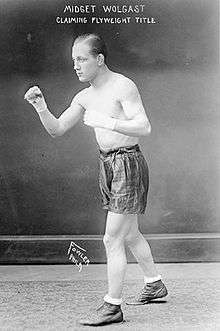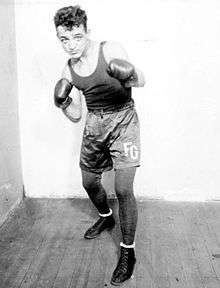Newsboy Brown
| Newsboy Brown | |
|---|---|
|
| |
| Statistics | |
| Real name | David Montrose |
| Rated at | Flyweight |
| Height | 5 ft 1 in (1.55 m) |
| Nationality |
|
| Born |
August 17, 1905 Russia |
| Died |
February 1, 1977 (aged 71) Los Angeles, California |
| Stance | Orthodox |
| Boxing record | |
| Total fights | 91 |
| Wins | 68 |
| Wins by KO | 12 |
| Losses | 13 |
| Draws | 10 |
David Montrose (August 17, 1905 – February 1, 1977), better known as Newsboy Brown, was an American boxer who held the World Flyweight Title for eight months in 1928.
Statistical boxing website BoxRec lists Brown as the #7 ranked flyweight of all-time.[1] He was inducted into the International Boxing Hall of Fame in 2012.[2] Brown was ranked the second-best bantamweight boxer in the world in The Ring magazine's Annual Ratings for 1931, and the fourth-best in January 1932 by the National Boxing Association. [3]
Early life and career
Born in Russia on August 17, 1905, Brown emigrated to the U.S. with his parents at the age of three months, though the exact date of his birth remains in some dispute. [4] Raised in Sioux Falls, Iowa, he learned to fight while selling newspapers on street corners like many young immigrant boxers. According to Brown, he weighted only 95 pounds when he first got into boxing. [5] He began boxing professionally around 1922, and early in his career used the name David Montrose. In one of his early fights, he acquired the name "Newsboy Brown" when a ring announcer introduced him without being certain of his name. His first eight fights ended in no decisions, but then Brown registered his first official win with a third-round knockout of John Walker in April 1924. [6]
Professional career highlights
First attempt at the NYSAC World Flyweight Championship

As part of the inaugural card for the famous Olympic Auditorium, he defeated Frankie Grandetta by points. Brown had two famous bouts against future World Flyweight Champion Corporal Izzy Schwartz. Brown beat him in 1925 but lost in a title bout to Schwartz for the NYSAC flyweight title on December 16, 1927. One newspaper summarizing the bout wrote, "Corporal Izzy Schwartz...outscored Newsboy Brown of Sioux City, Iowa throughout to win recognition in New York as the holder of the Flyweight Championship vacated recently by Fidel LaBarba."[7] Apparently Schwartz demonstrated superior scientific boxing skills and was better trained for the bout, though he was five years older than Brown who had not yet reached the peak of his boxing career at twenty-two. The Norwalk Hour, perhaps showing some local bias, wrote of the well attended bout in Madison Square Garden, that Schwartz was "too fast, shifty, and resourceful, for the plodding Brown, and won hands down." A more objective source noted that Brown had previously defeated Schwartz, and that he "entered as a slight favorite and forced the fighting throughout", despite losing in a unanimous decision.[8] It is interesting to note that the bout, though a NYSAC World Title match was not the headliner for the night but merely a semi-final. This was probably due to the greater popularity of other weight classes and the dispute over who held the World Flyweight Title at the time. Schwartz would receive his fair share of recognition for taking the Flyweight title and holding it for two years, but Brown would never reach the same level of notoriety holding the title for only eight months and only in the state of California.[9]
Taking the World Flyweight Title in 1928 (California)
In his next fight Brown won his most important and historic victory by beating Johnny McCoy on January 3, 1928 in a ten round bout for the flyweight world title as recognized in California. According to one source, "The Newsboy had lost only one fight in his last 15 in Los Angeles, and his last appearance–a defeat of Johnny Vacca–had been heralded as one of the best fights ever seen in the Olympic Auditorium." Brown won five rounds, McCoy only three, with two rounds even. Brown led in the first seven rounds, before McCoy came back in the last three, even knocking Brown to the canvas in the tenth, but it was too late to take the victory. Nonetheless, the results demonstrated that the boxers were evenly matched. Considering the decision, McCoy had waited too long to take control of the bout.[10]
Loss of the Flyweight Title

Brown defended the Flyweight title once by beating Philapinno Speedy Dado but lost it in when Johnny Hill won a decision over him on August 29, 1928 at the Orient Football Ground in London, becoming the first Scottish boxer to hold a world title. Brown continued to show promise after losing the title, defeating Midget Wolgast in Los Angeles in a non-title fight on August 19, 1930 in a decisive ten round bout. Had Wolgast consented to fight the bout for a title, Brown's fame and recognition in the sport would have taken a positive turn. It would not be the first time a title holder would dodge a title match with Brown. New London's The Day wrote, "Midget Wolgast recognized flyweight champ in New York and Pennsylvania, took a severe beating at the hands of Newsboy Brown, Los Angeles veteran trial horse, in a ten round non-title bout here." [11][12]

Brown was scheduled to meet Frankie Genaro for a second time on September 9, 1930 at the Olympic Auditorium in Los Angeles, but Genaro scheduled to fight Midget Wolgast instead, perhaps fearing that Brown could take back the National Boxing Association World Flyweight Title he held at the time or aware that a fight with champion Wolgast would be bring a bigger audience and be more lucrative. According to the Prescott Evening Courier, "The Olympic Auditorium (where the bout was to take place) has requested the New York Commission to force Genaro to meet Brown here according to a telegraphic agreement...and the New York Athletic Commission has signified it may take similar action if Brown defeats Laredo."[13] Whatever the reason, Brown defeated Mexican boxer Chato Laredo on September 9, 1930, in a decisive ten round match at the Olympic Auditorium but never again met Genaro, nor had a chance at the NBA Flyweight World Title. One explanation may be that Brown was beginning to move up in weight as he had originally scheduled to box Wolgast on September 9 over the flyweight limit. Brown would soon move up a weight class with considerable success.
Taking the California Bantamweight State Championship
He took the USA California Bantamweight State Championship on November 24, 1931, defeating Young Tommy in a ten round points decision in Olympic Stadium in Los Angeles. He defended it again facing Young Tommy on January 30, 1932 in Los Angeles.
Attempt at the World Featherweight Title
He fought Speedy Dado again in 1931, losing one bout and winning one. Later that year he defeated Panama Al Brown. In 1932 he fought his last title fight, losing a ten-round decision to Baby Arizmendi for the world featherweight title. According to one source Brown won only one round, explaining his reluctance to continue his career. He retired from boxing in 1933. [14]
His managers included Leo Flynn, Pop Nealis, Joe Levy, and Tom Kennedy by 1929, and Emmett Ledwith in 1932. [15]
Achievements
He was inducted into the International Boxing Hall of Fame in 2012.
| Preceded by Fidel LaBarba Vacated and Appointed Johnny McCoy |
World Flyweight Champion (California Only) January 3, 1928– August 29, 1928 |
Succeeded by Johnny Hill |
Retirement and work in Hollywood
After his boxing retirement, he broke into the motion picture business by coaching cowboy star Tom Mix in his fight scenes. As a result of his association with Mix, he landed a job in the properties department of one of the Hollywood studios, where he worked in his later years.
He helped with props for Columbia Picture's 1947 movie Johnny O'Clock directed by Robert Rossen. [16]
He died on February 1, 1977 in Los Angeles, California where he had conducted both his boxing and acting careers.
External links
References
- ↑ All-Time Welterweight Rankings. BoxRec.com. Retrieved on 2014-04-11.
- ↑ "Newsboy Brown Bio". International Boxing Hall of Fame. Retrieved May 28, 2012.
- ↑ "Newsboy Brown". BoxRec. Retrieved 18 March 2016.
- ↑ Ingram, Bob, "As I was Saying", El Paso Evening News, El Paso, Texas, p. 13, 7 May 1930
- ↑ Ingram, Bob, "As I was Saying", El Paso Evening News, El Paso, Texas, p. 13, 7 May 1930
- ↑ "Newsboy Brown". Jews in Sports. Retrieved 18 March 2016.
- ↑ "Glick Beats Tod Morgan 14 Rounds Than Loses on Foul", The Lewiston Daily Sun, pg. 10, Lewiston, Maine., 17 December 1927.
- ↑ "Newsboy Brown". Jews in Sports. Retrieved 18 March 2016.
- ↑ "Schwartz Outsmarts Newsboy Brown Iowa," The Norwalk Hour pg. 16, Norwalk, Connecticut, 17 December 1927
- ↑ "Newsboy Brown vs. Johnny McCoy". William B. Shubb, 1998. Retrieved 21 March 2016.
- ↑ "Newsboy Brown Gives Wolgast Severe Beating", The Day, pg. 5, New London, CT., 20 August 1930.
- ↑ "Newsboy Brown". BoxRec. Retrieved 18 March 2016.
- ↑ "Newsboy Challenges Reneging Flyweight," Prescott Evening Courier, pg. 3, Prescott, Arizona, 4 September, 1930
- ↑ "Newsboy Brown". BoxRec. Retrieved 18 March 2016.
- ↑ "Newsboy Brown". BoxRec. Retrieved 18 March 2016.
- ↑ "Newsboy Brown". Internet Movie Database. Retrieved 21 March 2016.